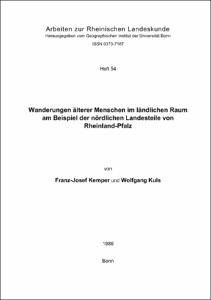Wanderungen älterer Menschen im ländlichen Raum am Beispiel der nördlichen Landesteile von Rheinland-Pfalz

Wanderungen älterer Menschen im ländlichen Raum am Beispiel der nördlichen Landesteile von Rheinland-Pfalz

| dc.contributor.author | Kemper, Franz-Josef | |
| dc.contributor.author | Kuls, Wolfgang | |
| dc.date.accessioned | 2020-10-21T14:47:29Z | |
| dc.date.available | 2020-10-21T14:47:29Z | |
| dc.date.issued | 1986 | |
| dc.identifier.uri | https://hdl.handle.net/20.500.11811/8711 | |
| dc.description.abstract | Die vorliegende Studie ist ein Beitrag zur Erforschung des Wanderungsverhaltens älterer Menschen, das aufgrund stetig wachsender Bedeutung in jüngerer Zeit nicht nur von wissenschaftlicher Seite her verstärkte Aufmerksamkeit gefunden hat, aber noch eine Vielzahl offener Probleme aufweist. Sie fügt sich in den Rahmen verschiedener Arbeiten über Wanderungsprozesse ein, denen am Bonner Geographischen Institut schon seit längerem ein besonderes Interesse galt. Eine maßgebliche Voraussetzung für die Durchführung empirischer Erhebungen bildete die finanzielle Unterstützung des Vorhabens durch die Deutsche Forschungsgemeinschaft, wofür die Autoren ihren besonderen Dank abzustatten wissen. Ihr Dank gilt gleichzeitig jenen Studierenden am Geographischen Institut der Universität Bonn, die in ausgewählten Gemeinden des Arbeitsgebietes unter mancherlei Schwierigkeiten mit großer Sorgfalt Befragungen von Migranten vorgenommen haben. Auf diesen Befragungen basiert der zweite Abschnitt des empirischen Teils der Untersuchung, während sich der erste Abschnitt auf großenteils unveröffentlichte Daten der amtlichen Statistik sowie auf eigens ermittelte Strukturmerkmale stützt. | de |
| dc.description.abstract | Migration of elderly people to Rural areas - the example of the northern part of Rhineland-palatinate
This study presents an investigation of retirement migration in a rural region which cannot be counted among the areas of highest attractiveness for elderly people in the Federal Republic of Germany, and therefore offers possibilities for the immigration not only of the upper middle class but of wider segments of the population. A major hypothesis postulates that retirement migration is not a homogeneous process but consists of different types rooted in the experience of migration during working life and the acquired competence of spatial behaviour. In part A, a review of the literature is given leading to a discussion of the current themes and the deficiencies of research an retirement migration. Part B presents the results of a first stage of analysis an an aggregate level. Relying an detailed data from the information-system of Rhineland-Palatinate, spatial distributions are described showing elderly in- and outmigration within an area of about 1000 communities. Furthermore, the distributions of different groups by age and sex are compared. By means of correlation and path analyses, some hypotheses about migration determinants could be tested. The distance to the Rhine-Ruhr-agglomeration and the equipment with recreation opportunities including footpaths proved to be the most important factors. In comparison to that, natural attractiveness and beauty stood back. For the elder migrants the supply with homes for the aged and with medical care had to be added. Whereas younger pensioners preferred small communities, the older and less mobile group tended to leave such villages in favour of towns. The second step of analysis, which is treated in part C, is based upon interviews with some 175 elderly migrants in selected communities. Different types of settlements (small town, health resort, village with touristic functions, agrarian community) were included. By means of their "migration-histories", the pensioners were grouped into types of migration (e.g. return migrant, repeated retirement migrant, migrant from nearby urban areas, long-distance migrant). It could be demonstrated that these types of migration were related to the sociodemographic characteristics and the motives of the migrants as well as to the settlement types. This confirms the general hypothesis concerning the heterogeneity of elderly migration. A comparison between conditions of housing and life before and after the migration showed that in general housing conditions had improved, frequently at the expense of deficiencies of infrastructure. The study finishes with an analysis of the spatial behaviour of the respondents focussing upon consumer trips, social contacts, and recreation activities. By means of a cluster analysis, four types of activity were distinguished (type of general activity, type of outdoor activities, type of club and social activities, type of general passivity). These types are connected both with the migration types as weil as with the types of migrant communities. | en |
| dc.format.extent | 103 | |
| dc.language.iso | deu | |
| dc.relation.ispartofseries | Arbeiten zur Rheinischen Landeskunde ; 54 | |
| dc.rights | In Copyright | |
| dc.rights.uri | http://rightsstatements.org/vocab/InC/1.0/ | |
| dc.subject | Koblenz (Region) | |
| dc.subject | Ländlicher Raum | |
| dc.subject | Alter | |
| dc.subject | Migration | |
| dc.subject.ddc | 300 Sozialwissenschaften, Soziologie, Anthropologie | |
| dc.subject.ddc | 550 Geowissenschaften | |
| dc.subject.ddc | 914.3 Geografie, Reisen (Deutschland) | |
| dc.title | Wanderungen älterer Menschen im ländlichen Raum am Beispiel der nördlichen Landesteile von Rheinland-Pfalz | |
| dc.type | Buch, Monografie | |
| dc.publisher.name | Dümmler Verlag | |
| dc.publisher.location | Bonn | |
| dc.rights.accessRights | openAccess | |
| dc.relation.pissn | 0373-7187 | |
| dc.relation.pissn | 3-427-71541-8 | |
| ulbbn.pubtype | Zweitveröffentlichung |




